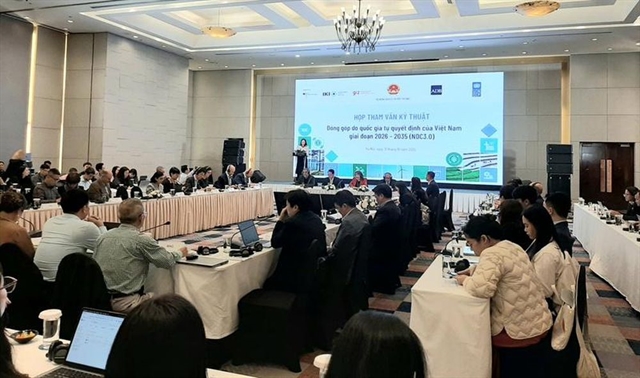 Life & Style
Life & Style

For expats working long hours in Ha Noi, back pain can frequently cause great discomfort and inconvenience. Laurel Winter, an experienced Australian physiotherapist who works with expats at Family Medical Practice Vietnam in HCM City and Ha Noi, shares her tips for dealing with back pain and office-related stress.
 |
| Physiotherapist: Dr Laurel Winter.—Photo courtesy of Family Medical Practice |
To your health
For expats working long hours in Ha Noi, back pain can frequently cause great discomfort and inconvenience. Laurel Winter, an experienced Australian physiotherapist who works with expats at Family Medical Practice Vietnam in HCM City and Ha Noi, shares her tips for dealing with back pain and office-related stress.
Low back pain (LBP) is pain in your lower back and buttock region. Approximately 80per cent of us will have a least one episode of LBP during our lives. It is the fifth most common reason people visit the doctor.
Almost all LBP is what we call non-specific -- or mechanical -- low back pain, which refers to pain in the lumbar region that is not the result of specific pathology such as a fracture, tumor or infection. There are usually three types of non-specific LBP: acute, sub-acute and chronic. This categorization is based on the duration of the back pain. Acute LBP is an episode of low back pain for less than 6 weeks, sub-acute LBP between 6 and 12 weeks and chronic LBP for 12 weeks or more.
Non-specific LBP is a huge economic burden. In the US, it is estimated US$50 million is spent on non-specific LBP each year. There are approximately 150 million work days missed due to non-specific LBP every year.
But there is good news!
Non-specific LBP is usually a self limiting condition. It will get better by itself with no medical intervention required. Half of the people with an acute episode of LBP will recover within two weeks without treatment. That number gets even better when we look at 3-4 months after the onset of LBP: 90 per cent of people with get better from non-specific LBP after this length of time!
Tips to ease lower back pain
So what should you do if you suffer an episode of LBP?
First run through a quick checklist to see if you have any red flags which may be signs or symptoms of more serious pathology. Ask yourself:
Have you had sudden changes in your bladder or bowel function, or numbness in your saddle region?
Do you had a fever?
Have you had recent, unexplained weight loss?
Have you had a recent fall or trauma?
Do you have osteoporosis?
If you answered yes to any of these questions, you should see your doctor or physiotherapist.
If you answered no to all of these questions, the best thing to do is to keep moving.
Only a few years ago, people with LBP were advised to spend time on best rest. But we now know that bed rest makes LBP worse. Over the counter analgesia, such as paracetamol, can be used to help control the pain to keep you moving. If paracetamol doesn’t quite cover the pain, your doctor can advise you on other medications that may be suitable.
Remember, movement is medicine! Any type of movement will do: walking, swimming, yoga, pilates. The list is endless.
Do you need an x-ray?
The short answer is no, unless you have any of the red flags mentioned above. An X-ray or MRI can be misleading. A study published in 2014 analyzed the MRI results for a large group of people who had never had back pain. The results were rather interesting. 37 per cent of 20 year olds and 96 per cent of 80 years olds with no back pain had "disc degeneration". 60 per cent of 50 year olds and 84 per cent of 80 year olds had "bulging discs".
So it turns out a lot of the changes that are seen on imaging are just part of the normal aging process.
X-rays and MRIs can often do more harm than good. Just by reading the scary sounding results, your back pain may become worse. Health professionals know that "disc degeneration" and "bulging discs" are rarely anything to worry about. Mostly they are just a normal sign of aging. But when you have LBP and read these scary words it often leads you to believe that back pain is harmful and disabling, which then leads to fear and avoidance of movement.
Movement is medicine, as we know. So being afraid to move will prevent or delay your LBP from getting better.
To recap: most of us will suffer from LBP during our lives. Most LBP is non-specific and will get better by itself, without medical intervention. If you have any red flags you should consult your doctor or physiotherapist. If you don’t have any red flags, keep moving and use over the counter analgesia if needed. If you are worried about your back pain, or if it is interfering with your life, contact your physiotherapist to help you get moving again!
--
Before working for Family Medical Practice Hanoi, Laurel Winter was a senior physiotherapist at a leading private rehabilitation hospital in Sydney. Winter has a special interest in treating complex conditions, athletic injuries and persistent pain conditions and injuries. She is a strong advocate for the importance of educating patients and providing them with specific exercises to manage and control pain on their own. Winter prides herself on helping clients maximize their function in order to achieve their rehabilitation goals, by combining manual therapy with functional exercise. When not at work, she participates in triathlons, indoor rock climbing, hiking and canyoning. For more information or medical advice, please contact: hanoi@vietnammedicalpractice.com




